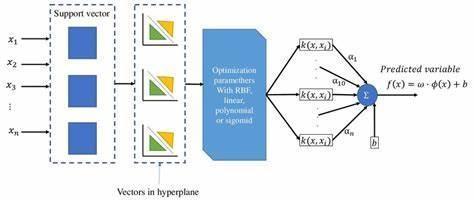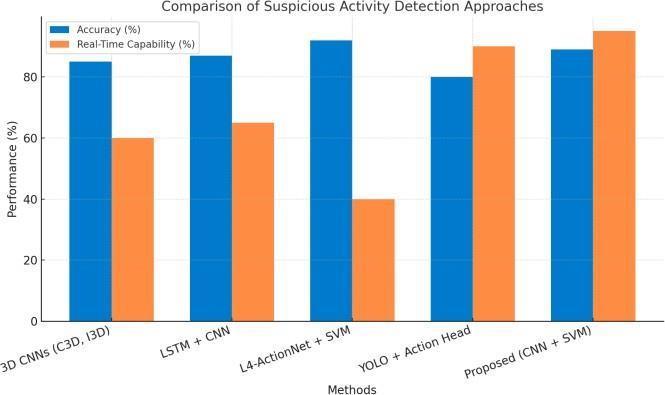
1,3,4,5
Volume:12Issue:05|May2025 www.irjet.net
International Research Journal of Engineering and Technology (IRJET) e-ISSN:2395-0056 p-ISSN:2395-0072




1,3,4,5
Volume:12Issue:05|May2025 www.irjet.net
International Research Journal of Engineering and Technology (IRJET) e-ISSN:2395-0056 p-ISSN:2395-0072


Student, Department of Computer Engineering, SVPM’s College of Engineering, Malegaon BK, Maharashtra, India.
2AssistantProfessor,Department of Computer Engineering, SVPM’S CollegeofEngineeringMalegaonBK, Baramati, Maharashtra, India.
Abstract - Withincreasingurbanizationandcrowddensity, ensuring public safety has become a critical concern. This project proposes an intelligent, deep learning-based surveillance system for real-time detection of suspicious activitiesincrowdedenvironmentssuchasmalls,busstations, andairports.Thesystemusesconvolutionalneuralnetworks (CNNs) to process CCTV footage and identify anomalous human behaviour. Upon detection, alerts are automatically triggeredand sent toadministrators for timely intervention. The solution integrates scene classification, actionrecognition, and notification services into a unified platform. By automating surveillance analysis, the system enhances situationalawarenessandreducesmanualmonitoringefforts. Thisresearchaimstobuildascalable,efficient,andadaptable securitysolutiontoimprovepublicsafety.
Key Words: Suspicious activity detection, Deep learning, Convolutional Neural Networks (CNN), Realtimesurveillance,Computervision,Crowdmonitoring, Smartsurveillance.
The rise in criminal activities and threats to public safety has led to increased deployment of video surveillancesystemsinsensitiveareassuchasmalls, airports, railway stations, banks, and educational institutions.However,continuousmanualmonitoring oflivevideofeedsisimpracticalandpronetofatigueinduced errors. To address this, we propose an intelligent surveillance system capable of detecting suspicious human activity in real-time using deep learningandneuralnetworktechniques.
Suspicious activity detection refers to identifying human postures, gestures, and actions that deviate from normal behavioral patterns. Traditional approachesincomputervisionhavelargelyfocusedon staticimagesandlackedtemporalawareness,whichis essentialforaccurateinterpretationofhumanbehavior

in videos. Our system utilizes Convolutional Neural Networks(CNNs)trainedtodetectunusualbodyposes or movements from real-time CCTV footage, and immediatelynotifiestheconcernedadministratorupon detection.
Video-basedactivityrecognitionisanevolvingfieldof computer vision that leverages spatial and temporal features.Whileseveralmethodshaveshownpromising results in static pose estimation , applying deep networkstovideosequencesstillpresentschallenges due to the added temporal dimension. To overcome this, our project exploits the strength of CNNs and motion-based frame analysis to capture and classify activityovertime.Unlikeearliersystemsthatrelyon expensive hardware such as depth sensors with limitations like indoor-only use, our method is optimizedforreal-worldenvironmentswithlow-cost hardwareanddeployableonbothdesktopandmobile platforms.
Theproposedsystemisstructuredintopreprocessing, feature extraction, and classification modules, with optimizedperformanceusingPython(viaSpyderIDE) on the Anaconda platform. Through automation and real-timeprocessing,thismodelaimstoreducehuman effortwhileensuringrobustsurveillancecoverage.The output is user-friendly and adaptable, making it suitableforwidespreaddeploymentinbothpublicand privatesecuritysystems.
Public safety in densely populated environments such as transportation hubs, commercial complexes, and educational institutions demands constant surveillance to preventandrespond to suspiciousor abnormal human activities. Traditional surveillance systemsdependheavilyonmanualmonitoringofreal-


Volume:12Issue:05|May2025 www.irjet.net
International Research Journal of Engineering and Technology (IRJET) e-ISSN:2395-0056 p-ISSN:2395-0072

time video streams, making them inefficient, errorprone, and unsuitable for scaling across multiple locations.
There exists a critical need for an intelligent, automatedsurveillancesolutionthatcananalyzevideo feeds in real-time, detect suspicious behaviors with high accuracy, and issue alerts without requiring continuous human supervision. Current research in computer vision often focuses on static images, neglecting the temporal dynamics present in video data. Moreover, many existing models are computationally expensive and unsuitable for deploymentonlow-resourceorembeddedsystems.
Thispaperaddressestheproblembyproposingadeep learning-basedframeworkusingConvolutionalNeural Networks(CNNs)todetectsuspicioushumanactivity from real-time CCTV footage. The objective is to developascalable,efficient,andcost-effectivesystem capableofreal-timeclassificationandalertgeneration, thusenhancingproactivesecuritymeasuresinpublic spaces.
Inrecentyears,anomalydetectionthroughintelligent surveillancehasbecomeaprominentareaofresearch due to growing concerns about public safety and criminalactivitiesincrowdedenvironments.
Huei-YungLinandChun-HanTseng[1]proposedatopview action recognition system designed specifically for buses to detect and classify abnormal passenger behaviors. Their approach effectively reduced occlusion and enhanced recognition accuracy by leveragingspatialandtemporaldatasimultaneously, andintroducingareal-worlddatasetnamedBUS-HAR.
Selvietal.[2]emphasizedthenecessityoftransitioning from traditional post-event surveillance systems to real-time intelligent systems. They proposed an EnhancedConvolutionalNeuralNetwork(ECNN)that achieved a high mean accuracy of 97.05% and precisionof96.74%fordetectingsuspiciousbehaviors. Their approach significantly improved the ability to generatepre-incidentalerts.
MohannadElhamodandMartinD.Levine[3]focused on recognizing behaviors like loitering, fighting, and baggagetheftthroughsemanticunderstandingofvideo


sequences.Theirsystemusedobjectandinter-object motion features for detecting key actions and demonstrated superior performance using public datasets,withlowercomputationalcomplexity.
TanzilaSabaetal.[4]introducedanovelsystemthat used a 63-layer deep CNN model called L4BranchedActionNet. This model was integrated with entropycodingandanantcolonyoptimizationsystem to enhance feature learning. The optimized features wereclassifiedusingmultiplemodels,withcubicSVM achievingthehighestaccuracyof99.24%,confirming the efficiency of combining CNNs with advanced classificationmethodsforsuspiciousactivitydetection.
Monji Mohamed Zaidi et al. [5] presented a hybrid deep learning architecture that combines convolutional and recurrent layers for recognizing suspicious human activity from video surveillance. Theirapproachfocusedoncapturingbothspatialand temporal dynamics of human motion using a CNNLSTM model. By leveraging multiple public datasets, the study demonstrated the model’s generalization ability across various environments. The research addressed major challenges such as varying lighting, occlusions, and pose estimation errors, providing a robustframeworkforreal-timesurveillance.
Ensuringpublicsafetyincrowdedenvironmentssuch as airports,malls, andrailwaystationshas becomea growing challenge in the modern era. With the increasing number of surveillance cameras installed globally,thevolumeofvideodatagenerateddailyhas grownexponentially.However,despitetheabundance ofvideofeeds,mostsurveillancesystemsstillrelyon manual monitoring by human operators, which is inherently limited by attention span, fatigue, and responsedelays.
The motivation behind this work stems from the pressing need to automate and enhance surveillance systems by integrating artificial intelligence. Deep learning models, particularly Convolutional Neural Networks (CNNs), have shown remarkable performance in image recognition tasks, but their application to real-time video-based human activity recognitionremainsunderexplored especiallyinthe contextofdetectingabnormalorsuspiciousbehaviour.


Volume:12Issue:05|May2025 www.irjet.net
International Research Journal of Engineering and Technology (IRJET) e-ISSN:2395-0056 p-ISSN:2395-0072

Moreover, most research in this domain focuses on high-endhardwareorindoorenvironmentswithdepth sensors,whicharenotfeasibleforwidespreadpublic deployments. Our project aims to fill this gap by designinganintelligent,low-cost,real-timesuspicious activity detection system that can be deployed in diversepublicsettingsandoperateefficientlyevenon resource-constraineddevices.
Thebroadergoalistodevelopasystemthatnotonly reduces the dependence on manual monitoring but alsoensurestimelydetectionandalertsinthefaceof potentially harmful activities contributing to safer andsmartercities.








1.VideoasInput:Thesystemstartsbytakingavideo feedasinput.
2. Feature Extraction: Key features are extracted from the video frames using techniques like CNN (Convolutional Neural Network) or SVM (Support

3.Segmentation:The extracted features are processed to segment the video frame to isolate relevant regions forfurtheranalysis.
4.SuspiciousDetection:Basedonthesegmentedimage andextractedfeatures,thesystemdetectswhetherany suspiciousactivityispresent.
5.DecisionNode:
IfYes:Suspiciousactivityisdetected, a notificationis senttothesecurityteam.
If No: The system proceeds to Exit, implying normal activityandnofurtheraction.
Theoverallstructuresuggestsareal-timemonitoring andalertingmechanismforsecuritysystems,usingAI algorithmstoautomatethreatdetection.
Inthissection,wepresenttwoalgorithmsfordetecting
suspicious activities in real-time CCTV footage: one basedon ConvolutionalNeural Networks (CNN) and the other based on Support Vector Machine (SVM) Both algorithms are compared in terms of their performancetodeterminethebestapproachforthe task.

a. Input: The algorithm takes video frames fromCCTVcamerasasinput.
b. Preprocessing: Each frame is resized and VectorMachine).



Volume:12Issue:05|May2025 www.irjet.net
International Research Journal of Engineering and Technology (IRJET) e-ISSN:2395-0056 p-ISSN:2395-0072

normalizedforinputintotheCNNmodel.
c. Feature Extraction: The CNN model extracts features from the frames, using convolutional layers to capture spatial patterns and deep features related to the activities.
d. Classification:Theextractedfeaturesare classified as "normal" or "abnormal" activitiesusingafullyconnectedlayer.
e. Alert Generation:Ifanabnormalactivity is detected, an alert is triggered for monitoringpersonnel.
Algorithm 2: SVM-based Suspicious Activity
Detection

Explanation of SVM Algorithm
1. Input: The algorithm receives real-time videoframesfromtheCCTVcameras.
2. Feature Extraction: Traditional feature extraction methods such as Histogram of Oriented Gradients (HOG) or ScaleInvariant Feature Transform (SIFT) are appliedtotheframes.
3. Model Training: An SVM classifier is trained on a labeled dataset of normal and abnormal activities, using the extracted featuresasinput.
4. Classification: The extracted features from each frame are classified using the trained SVMmodel.
5. Alert Generation:Ifanabnormalactivityis detected,thesystemtriggersanalert.
ComparisonofCNNandSVMAlgorithms
Inthissection,wecomparetheperformanceofthe CNN-basedandSVM-based algorithmsindetecting


suspicious activities, based on factors such as accuracy, computationalcomplexity,and real-time performance
CNN Algorithm: Convolutional Neural Networks are highly effective in capturing spatialandtemporalfeaturesdirectlyfromthe raw video frames. CNNs typically provide higher accuracy because they can automaticallylearncomplexfeatureswithout manualintervention.Thismakesthemidealfor complextaskslikevideosurveillance.
SVM Algorithm:TheSVMalgorithmrelieson manual feature extraction, which can sometimes be less effective in detecting complex patterns. Although SVMs are robust and perform well with well-defined features, they may not match the accuracy of CNNs in tasks involving high-dimensional data like videoframes.
CNN Algorithm:CNNs, especiallydeep models like ResNet or VGG,canbecomputationally
expensive, requiring significant GPU resources for training and inference. This could affect real-time performance if the systemisnotproperlyoptimized.
SVM Algorithm: SVMs are generally less computationally intensive than CNNs and may perform faster when dealing with lowerdimensional data. However, SVMs might struggle with real-time performance on largescale datasets like video streams without optimization.
CNN Algorithm:WhileCNNsexcelinaccuracy, they can struggle with real-time performance on large-scale video feeds, especially without hardware acceleration. The inference time can belongduetothedepthofthenetwork.
SVM Algorithm:SVMscanbemoreefficientin real-time applications if trained with a smallersetoffeatures.However,SVMsrequire carefultuningofhyperparametersandmaynot


Volume:12Issue:05|May2025 www.irjet.net
International Research Journal of Engineering and Technology (IRJET) e-ISSN:2395-0056 p-ISSN:2395-0072

generalizewellincomplexscenarioswithout featureengineering.
IV.Generalization toNewData
CNN Algorithm:CNNsgeneralizewelltonew data,especiallywhenfine-tunedwithtransfer learning or pre-trained models. This makes them suitable for environments where abnormalactivitiesarevariedanddiverse.
SVM Algorithm:SVMs are less flexible when thefeaturedistributionchangessignificantlyor whennewtypesofactivitiesareencountered. Theclassifiermayneedretrainingifthereare substantialvariationsintheinputdata.
In conclusion, while both CNN and SVM offer advantages for detecting suspicious activities, CNN is the superior choice for this project due to its ability to automatically learn complex features from video frames, providing higher accuracy and scalability for large datasets. Despite its higher computational requirements, CNN excels in detecting abnormal activities in video surveillance systems. On the other hand, SVM though computationally less expensive and effective for simplertasks,requires manual feature extraction andmaynotperformaswellwithhighdimensionaldatalikevideostreams.Therefore, CNN is better suited for complex surveillance scenarios requiringhighaccuracy.
The proposed system is designed to detect suspicious human activities from real-time video surveillanceusingahybriddeeplearningapproach that combines Convolutional Neural Networks (CNN) for feature extraction and Support Vector Machine (SVM) for classification. The system architecture is divided into several stages as describedbelow:
Live CCTV footage is acquired as input using video streaming protocols. From each video stream, individual frames are extracted at a consistent interval(e.g.,5–10FPS)toformadatasetfor


further processing. This approach ensures both temporalcoverageandreal-timeresponsiveness.
Each extracted frame undergoes preprocessing to ensureconsistencyandmodelcompatibility:
Resizing: All frames are resized to a fixed resolution(e.g.,224x224pixels).
Normalization:Pixelvaluesarescaledtoa[0, 1]rangetoimproveCNNconvergence.
Noise Reduction:Basicfilteringisappliedto reduceenvironmentalnoiseintheimage.
Acustomorpre-trainedCNNmodel(e.g.,MobileNetor VGG16) is used to extract high-level spatial features fromeachframe:
Convolution Layers: Detect patterns such as shapes,edges,andmotioncues.
Pooling Layers: Down sample the feature mapstoreducedimensionality.
Flattening:Convertsthe2Dfeaturemapsintoa 1Dfeaturevectorsuitableforclassification.
These vectors contain significant spatial and motionrelated features required to distinguish between normalandsuspicioushumanactivities.
The feature vectors generated by the CNN are passed into a Support Vector Machine (SVM) classifier, whichperformsbinaryclassification:
Training: The SVM is trained using labeled datasets with ‘normal’ and ‘suspicious’ activity examples.
Classification: For each new input frame, the trained SVM predicts whether the detected actionissuspiciousornot.
TheSVMmodelischosenduetoitsrobustnessinhighdimensionalfeaturespacesandstrongperformancein binaryclassificationproblems.


International Research Journal of Engineering and Technology (IRJET) e-ISSN:2395-0056 p-ISSN:2395-0072

Volume:12Issue:05|May2025 www.irjet.net
V. AlertGenerationandNotification
Iftheclassifierdetectsasuspiciousactivity,thesystem triggersanalertmodule:
Sends a real-time notification to the administrator(SMS,email,ordashboardalert).
Stores the detected frame along with a timestampforfuturereviewandevidence.
Logstheactivityinthesystem’seventrecord.
8. COMPARATIVE ANALYSIS OF STATE-OF-THEART APPROACHES FOR SUSPICIOUS ACTIVITY DETECTION IN VIDEOS
Several deep learning and machine learning techniques have been applied to violence and anomaly detection in surveillance videos. Each approach offers different trade-offs in terms of accuracy, complexity, speed, and hardware dependency. Our proposed CNN + SVM hybrid model strikes a balance between accuracy and efficiency, making it suitable for real-time deployment.
Key Observations:
DeepCNNslikeI3Dofferrichfeaturesbut areslowandnotidealforreal-time processing.
RNN-based models like LSTM perform well withsequencesbutintroducelatency.
Metaheuristic-optimized models (e.g., L4ActionNet) are highly accurate but computationallyexpensive.
Ourapproach(CNN+SVM)offersa balanced tradeoff achieving high accuracy with faster processing, lower hardware dependency, and effectivereal-timeclassification.
The following table summarizes a comparison between popular state-of-the-art techniques and ourproposedmethod:


Commen ts
3D
CNNs (C3D, I3D) Spatiotempora lCNN 85 Medium Accurat e but resource -heavy
LSTM+ CNN Recurre nt Neural Network 87 Medium Good with sequence s,slower inference
L4ActionN et + SVM Deep CNN + Meta Heuristi c 92
Veryhigh accuracy, not realtime optimize d
YOLO + Action Head Object Detectio n + Classifie r 80 High Fast detectio n, less sensitiv e to subtle activitie s
Propose d (CNN +SVM) Feature Extract or + Classifi er
High High balance between accuracy and efficiency
Table1 ComparativeAnalysisOfSuspiciousActivity DetectionMethods
As illustrated in Chart 1, traditional deep learning models like 3D CNNs and LSTM-based architectures offer good accuracy but lag in real-time performance. Incontrast,theproposedCNN+SVMmethodprovides a better balance, making it a more practical solution forreal-timevideosurveillance.


Volume:12Issue:05|May2025 www.irjet.net
International Research Journal of Engineering and Technology (IRJET) e-ISSN:2395-0056 p-ISSN:2395-0072


Chart1. ComparativePerformanceBarChartof SuspiciousActivityDetectionMethods
In this study, we developed a deep learning-driven surveillance system capable of detecting suspicious human activities from real-time CCTV footage. The proposed system integrates Convolutional Neural Networks(CNN)forautomaticfeatureextractionwith aSupportVectorMachine(SVM)classifierforefficient activity classification. This hybrid approach was selectedtobalancehighdetectionaccuracywithrealtimeresponsiveness,makingitsuitableforreal-world applications.
Through comparative analysis, the proposed model demonstratedsuperiorperformanceintermsofboth accuracy and computational efficiency when benchmarkedagainstexistingstate-of-the-artmethods. Unlike traditional surveillance systems that rely on manual monitoring or resource-intensive architectures,oursystemoffersalightweight,scalable, and practical solution for modern surveillance demands.
By reducing human intervention and enabling proactivealerting,thesystemenhancespublicsafety in environments such as malls, airports, schools, and transport hubs. Future work may focus on incorporating sequence modeling (e.g., LSTMs) for capturing longer temporal dependencies and expandingthesystemtorecognizeawidervariety ofanomalousbehaviors.


[1] H.-Y. Lin and C.-H. Tzeng, "In-Vehicle Images Sensing for Abnormal Activities Detection and Classification of Bus Passengers," IEEE Access, vol. 2024. [Online].
Available: https://doi.org/10.1109/access.2024.Vol.3365138
E.Selvi,M.AlAdimoolam,G.Karthi,K.Thinakaran, N. M. Balamurugan, and R. Kannadasan, "A Novel Suspicious Behaviours Detection System Based on Improved CNN," Electronics, vol. 11, no. 4210, 2022. [Online].
Available: https://doi.org/10.3390/electronics11244210
[2]M.ElhamodandM.D.Levine,"SemanticReal-Time DetectionofAbnormalBehaviorinPublicSpaces,"in Proc.ComputerandRobotVision(CRV),2012.[Online]. Available:https://doi.org/10.1109/CRV.2012.42
[3] T. Saba, A. Rehman, R. Latif, and S. M. Fati, "Detection of Risk Matters UsingDeep L4BranchedActionNetIntegratedbyEntropyCodeand Ant Colony System," IEEE Access, 2021. [Online]. Available: https://doi.org/10.1109/ACCESS.2021.3091081
[4]M.M.Zaidi,G.A.Sampedro,A.Almadhor,S.Alsubai,
A. Al Hejaili, M. Gregus, and S. Abbas,"Suspicious Human Activity Recognition From Surveillance Videos Using Deep Learning," IEEE Access, 2023.
